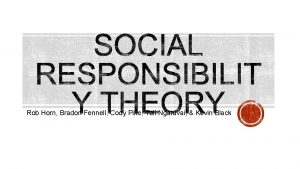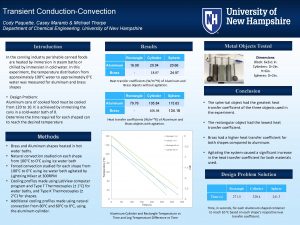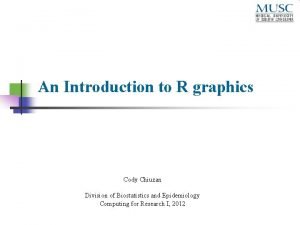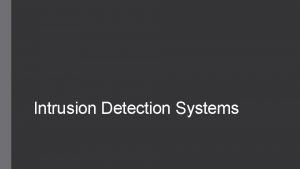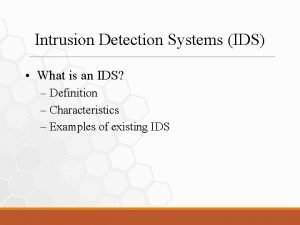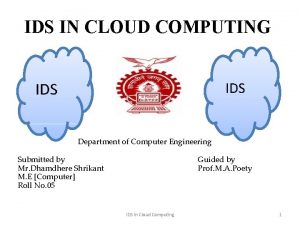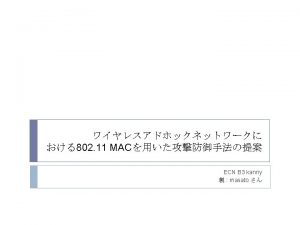A Nuclear Future Cody Rimes IDS 3303 4

























- Slides: 25

A Nuclear Future Cody Rimes IDS 3303 4 -9 -09

Introduction • America is facing some tough decisions when it comes to our power needs. • We consume 25% of the world's energy, but account for only 5% of the population. • This can be a little misleading, as we also account for 22% of the world's productivity. • Our energy needs are expanding, while resources are limited.

Timeline • (1905) baby. Einstein's Special Theory of Relativity. E= mc^2, • (1932) The first atom is split. • (1939) The first Uranium atoms are split. • (1939 -1945) The Manhattan Project. The US government contracted scientists to build the first atom bomb out in New Mexico. • (1945) Boom. The first, and incidently, the last time large scale nuclear weapons are deployed on major cities. (Gosling, 1999) • (1946) Nuclear technology is first used for something other than killing.

Cont. • (1946) The Atomic Energy Commission is founded. • (1951) A usable amount of electricity is produced from Nuclear Energy. • (1954) Atomic Energy Act of 1954. • (1957) International Atomic Energy Agency is founded. • (1986) Island. ) Chernobyl (and a few years earlier, Three Mile

Major Energy Resources • • Petroleum Coal Natural Gas Nuclear

How our Energy Needs are Met

Petroleum • Accounts for 38% of our total power usage. • US consumption is around 21 million barrels per day, while domestic production is only 6 million barrels per day.

Con’s of Petroleum (OIL) • A large contributor of greenhouse gases in the atmosphere. • Reliance on foreign supplies. America imports the vast majority of its oil at great cost. • Political concerns. Much of the oil we use is produced in politically unstable regions. Global disruptions in supply are a concern.

Where is all of the Oil?

By Country

Coal • Most abundant type of fuel in America. • About half of our electricity is generated using coal. • Accounts for around 26% of our total power usage.

Con’s of Coal • Extremely “dirty. ” The burning of coal releases more carbon dioxide than anything else. • Lbs of CO 2 per M BPUs of energy. --->

Natural Gas • Accounts for around 22% of our total energy use.

Con’s of Natural Gas • Even though it is 'better' on the environment, it is still a fossil fuel. Once burned, it releases carbon dioxide and other dangerous chemicals into the atmosphere. • It takes up a lot of space, making it less practical for transportation uses. Speeding from the scene of the crime, a Chinese boy tows a floating plastic bag of stolen natural gas.

Nuclear • Accounts for around 8% of our total energy use. • Has a lot of public outcry against its use within our borders.

Pro’s of Nuclear • It doesn't produce the greenhouse gases that are present in other forms of energy. • There is plenty of 'fuel' available to power nuclear energy for many years. • No dependence on unstable foreign supply. • Safer than many people think.

Uranium

How much fuel is out there? • As a fuel source, it is the cheapest of all, producing more power per dollar spent than any of the conventional fossil fuels (WNA, 2008). • Some estimates say that at current technology levels and current consumption, we have between 100 -300 years of fuel left to power our nuclear plants. (IAEA, 2006). • Though in actuality, estimates for uranium supplies vary widely; if breeder reactors and fuel reprocessing are assumed, estimates tend to be tens of thousands of years or longer. The technology for such is available now, but because of the availability of Uranium, we don't reprocess our waste currently.

More Fuel on the Way? • Current estimates put our worldwide reserves of Uranium at around 5 -6 million tons on land, though surveying methods have not been perfected because demand isn't that high. • According to research by the Japanese government, the ocean has vast untapped amounts of Uranium.

Fast Breeder Reactors • Can harness much more energy from Uranium than traditional reactors. • Can be built to use Thorium, which is 3. 5 times more common than Uranium. May also use U-238, an isotope of Uranium that is far more common than the U-235 we currently use. 99. 3% of all Uranium is U-238. • Can use reprocessed fuel, multiplying the lifetime of fuel by more than 60 (UIC), and lowering the volume of waste by 90%.

Breeder Reactor

How Dangerous is Nuclear Power? • Not as bad as many people think. • When people talk about Chernobyl and the lives lost from Cancer following it, they often forget about the many thousands of people that have died in coal mining, for example. • In general, fears have been overstated. There are examples out there of how safe nuclear energy can be.

Cancer Risks near Plants • A common safety concern that people have is that the area around nuclear power plants are dangerous because of radiation. The claim is that it is not safe to be close to the plants because of Cancer concerns. • The National Cancer Institute performed a study to ascertain the dangers of living close to nuclear power plants. They found no correlation between living proximity to a nuclear plant and cancer risks. (Cancer. gov)

Cancer Risks in Workers • If anybody is suffering from radiation, it would be the workers at these plants, right? • An article written by OSHA and posted on the CDC website covers a study that was conducted on laboratory workers in nuclear energy plants. The study concluded that these workers were actually LESS likely to die of Cancer than the general population (cdc. gov)

The Future? • Our population is booming, and our energy production must ramp up to meet the demand. Where will we look to solve our power crises? It is clear that we cannot continue to wreck our atmosphere with the burning of fossil fuels for much longer. Because of the implications of relying on unstable foreign regions and the fact that we must do more to avert global climate change, we can not expect to meet the demand with fossil fuels. • There is so much promise in nuclear power that growth in the industry seems certain.
 Future perfect continuous example
Future perfect continuous example Future perfect simple and continuous
Future perfect simple and continuous Lesson 15 nuclear quest nuclear reactions
Lesson 15 nuclear quest nuclear reactions Fisión nuclear vs fision nuclear
Fisión nuclear vs fision nuclear Vers ritmus
Vers ritmus Des rimes
Des rimes Páros rímes versek
Páros rímes versek Poésie rimes croisées
Poésie rimes croisées Sortes de rimes
Sortes de rimes Paraules que rimen amb sol
Paraules que rimen amb sol Rob bradon
Rob bradon Mike filsaime
Mike filsaime Coraline and the secret door inkagames
Coraline and the secret door inkagames Cody albright
Cody albright Cody lingua
Cody lingua He had passed visibly through two states
He had passed visibly through two states Cody hawk
Cody hawk Michael cody steam
Michael cody steam Cody taylor
Cody taylor Kelsey grammer marriages
Kelsey grammer marriages Cody wiberg
Cody wiberg Radial drawing
Radial drawing Cody bonk
Cody bonk Cody kees
Cody kees Cody chiuzan
Cody chiuzan East egg symbolism in the great gatsby
East egg symbolism in the great gatsby










